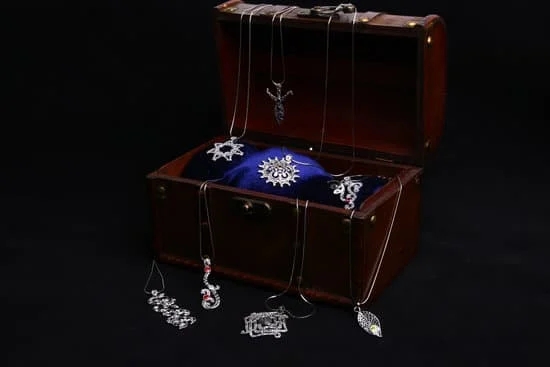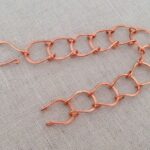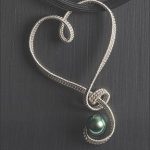Are you interested in learning how to make clay jewelry beads? This artful and intricate craft allows for the creation of unique, personalized jewelry pieces that showcase your creativity.
Understanding the art of handmade jewelry involves mastering the techniques of shaping, baking, coloring, and designing clay beads to perfection. Whether you’re a beginner or an experienced crafter, this guide will provide you with essential tips and step-by-step instructions on how to create your own beautiful clay jewelry beads.
Handmade jewelry has always been a symbol of individuality and creativity. Clay jewelry beads are a perfect example of this art form, allowing artisans to express their unique style and personality through their creations. In this section, we will delve into the world of clay jewelry beads, exploring the tools and materials needed for this craft, as well as the different types of clay suitable for making stunning jewelry pieces.
Creating clay jewelry beads is a labor of love that requires patience, precision, and attention to detail. From understanding the characteristics of different types of clay to learning various techniques for shaping and designing beads, there are many aspects to consider when venturing into this craft.
As we explore the step-by-step process of making clay jewelry beads in the following sections, you’ll gain valuable insights into this intricate art form and unlock your creative potential in crafting beautiful handmade jewelry.
Essential Tools and Materials for Making Clay Jewelry Beads
Making clay jewelry beads requires a specific set of tools and materials to ensure the quality and durability of the finished product. Some essential tools for this craft include a rolling pin, clay cutters, needle tool, sandpaper, baking tray, and an oven. Additionally, you will need various materials such as polymer clay, bead cores, jewelry findings, paint or dye for coloring, and a sealant for finishing.
Polymer clay is the most commonly used type of clay for making jewelry beads due to its versatility and ease of use. It comes in a wide range of colors and can be easily molded into different shapes and sizes. When choosing polymer clay for your project, consider factors such as the intended design of your beads and whether you want it to have a matte or glossy finish.
In addition to the clay itself, bead cores are essential for creating durable jewelry pieces. Bead cores are used to strengthen the inside of the bead and provide a base for stringing onto wire or thread. They come in various sizes and materials such as metal or plastic. Choosing the right bead core will depend on the size and weight of your beads, as well as personal preference.
Finally, having a variety of jewelry findings such as jump rings, clasps, and ear wires is important for assembling your finished beads into wearable jewelry pieces. These findings come in different metals and finishes to complement your designs. Understanding how to make clay jewelry beads involves not only shaping and baking but also selecting high-quality tools and materials to ensure professional results.
| Tools | Materials |
|---|---|
| Rolling pin | Polymer clay |
| Clay cutters | Bead cores |
| Needle tool | Jewelry findings |
| Sandpaper | Paint or dye |
Choosing the Right Type of Clay for Your Jewelry Beads Project
When it comes to making clay jewelry beads, choosing the right type of clay is essential for the success of your project. There are various types of clay available, each with its own unique properties and characteristics. The most common types of clay used for making jewelry beads are polymer clay, air-dry clay, and ceramic clay.
Polymer clay is a versatile and popular choice for making jewelry beads due to its flexibility and ability to hold intricate designs. It can be easily cured in an oven at a low temperature, making it convenient for crafting at home.
Air-dry clay is another option for creating jewelry beads, as it does not require baking in an oven. This type of clay air dries naturally and is available in a variety of colors, allowing for creativity in bead-making.
Ceramic clay is fired in a kiln to create durable and long-lasting jewelry beads. While it requires access to a kiln for firing, ceramic clay yields beautiful and high-quality results that are perfect for more professional jewelry-making projects.
In choosing the right type of clay for your jewelry bead project, consider factors such as the level of detail you want to achieve, whether you have access to an oven or kiln for curing/firing, and the overall aesthetic you wish to achieve with your handmade beads.
Table:
| Type of Clay | Properties |
|---|---|
| Polymer Clay | Flexible, holds intricate designs, cured in oven |
| Air-Dry Clay | No need for baking, available in different colors |
| Ceramic Clay | Fired in kiln, durable results |
Step-by-Step Guide to Making Clay Jewelry Beads
To make clay jewelry beads, you will need a few essential tools and materials. First, you will need polymer clay, which is the most popular type of clay for making jewelry beads. You can choose from a wide variety of colors, allowing you to create beads in any shade imaginable. In addition to polymer clay, you will also need shaping tools such as rolling pins, cutters, and bead rollers to create the desired shapes and sizes for your beads.
Once you have your tools and materials ready, it’s time to start creating your clay jewelry beads. Start by conditioning the clay to make it soft and pliable. Then, roll the clay into small balls or any other shape you desire for your beads.
You can use your hands or shaping tools to create different textures and patterns on the surface of the beads. Once you are satisfied with the shapes and designs of your beads, it’s time to bake them according to the instructions on the polymer clay packaging.
Baking is an important step in making clay jewelry beads, as it hardens the clay and sets the designs in place. Make sure to carefully follow the recommended baking temperature and time for the specific brand of polymer clay you are using.
Once baked, allow the beads to cool before moving on to adding color and designs or finishing and polishing them for a professional look. With these steps in mind, you’ll be well on your way to creating beautiful handmade clay jewelry beads for your next jewelry-making project.
Adding Color and Designs to Your Clay Jewelry Beads
Adding color and unique designs to your handmade clay jewelry beads can really make them stand out. There are several techniques you can use to enhance the beauty of your jewelry beads, whether it’s through simple solid colors or intricate patterns.
Painting Your Beads
One way to add color to your clay jewelry beads is by painting them. Once your beads are fully shaped and baked, you can use acrylic paint or nail polish to add vibrant colors to your beads. This allows for endless possibilities in terms of design and style. You can create a solid color, ombre effect, or even paint intricate patterns on each bead.
Mixing Different Colored Clays
Another technique for adding color to your clay jewelry beads is by using different colored clays. By mixing different colored clays together, you can create unique marbled effects that will give each bead a one-of-a-kind look. This is a great way to add depth and dimension to your jewelry pieces.
Adding Texture and Patterns
To make your clay jewelry beads even more visually appealing, consider adding texture and patterns. You can use various tools such as stamps, texture sheets, or even household items like buttons or lace fabric to create interesting patterns on the surface of your beads. This will give your jewelry a more customized and handcrafted look.
By applying these tips and techniques, you can elevate the look of your handmade clay jewelry beads, making them truly special and personalized. Whether you choose to paint, mix clays, or add texture and patterns, these methods will help transform simple clay beads into stunning pieces of wearable art.
Finishing and Polishing Your Clay Jewelry Beads for a Professional Look
Smoothing the Surface
Once your clay jewelry beads have been shaped and baked, it’s important to smooth out any rough edges or imperfections. One way to do this is by using sandpaper with a fine grit. Gently sand the surface of the bead until it feels smooth to the touch. Alternatively, you can also use a small piece of denim fabric to rub the surface of the bead, which will help achieve a polished finish.
Sealing and Protecting
After smoothing the surface of your clay jewelry beads, consider sealing them for added protection and shine. A popular method for sealing polymer clay beads is by using a clear gloss varnish or resin. Apply a thin coat of varnish or resin to each bead and allow it to dry according to the product‘s instructions. This will not only protect the beads from wear and tear but also give them a professional glossy finish.
Adding Shine With Buffing
If you prefer a more subtle sheen on your clay jewelry beads, you can opt for buffing instead of sealing. Using a soft cloth or polishing pad, gently buff each bead in circular motions until it achieves your desired level of shine. Be sure to use a clean cloth and avoid using excessive force to prevent any damage to the surface of the beads.
By following these finishing and polishing techniques, you can elevate the overall look of your handmade clay jewelry beads, making them appear professional and ready for use in your unique creations.
Creative Ideas for Using Clay Jewelry Beads in Different Types of Jewelry
Now let’s explore some creative ideas for using clay jewelry beads in different types of jewelry. There are countless ways to incorporate handmade clay beads into your jewelry-making projects, whether you prefer a bohemian, minimalist, or elegant style. Here are some inspiring ideas to get you started:
- Create a statement necklace: Use a mix of different shapes and sizes of clay beads to design a bold and eye-catching necklace. You can experiment with various color combinations and patterns to make your necklace truly unique.
- Design a charm bracelet: Add personality to your bracelet by making custom clay beads that represent meaningful symbols or objects. Whether it’s a heart, star, or animal-shaped bead, each charm can tell its own story.
- Earrings with a twist: Instead of traditional metal or gemstone earrings, try making lightweight and colorful clay bead earrings. You can play with asymmetrical designs or create matching sets for a cohesive look.
These are just a few ideas to spark your creativity when it comes to incorporating clay jewelry beads into your projects. Don’t be afraid to think outside the box and experiment with different styles and techniques.
Remember, the beauty of working with clay is that you have the freedom to shape and customize the beads exactly how you want them. Whether you’re making jewelry for yourself or as gifts for others, handmade clay jewelry beads add a personal touch that can’t be replicated with mass-produced materials. With some creativity and patience, you can elevate your jewelry designs with unique and beautiful clay beads.
Tips for Caring for and Maintaining Your Handmade Clay Jewelry Beads
Making clay jewelry beads is a fun and creative way to add a personal touch to your jewelry collection. Once you have finished crafting your beautiful clay beads, it’s important to know how to care for and maintain them to ensure they last for a long time. Here are some tips for keeping your handmade clay jewelry beads in top condition:
Storage
Proper storage is essential for maintaining the quality of your clay jewelry beads. Store them in a cool, dry place away from direct sunlight to prevent fading or discoloration. Consider using a jewelry box with individual compartments or a small container with soft padding to prevent scratching.
Cleaning
It’s important to clean your clay jewelry beads regularly to remove any dirt, oil, or sweat that may have accumulated on the surface. Use a soft, damp cloth to gently wipe the beads clean. Avoid using harsh chemicals or abrasive cleaning agents as they can damage the clay.
Avoid Water and Chemicals
Clay jewelry beads are porous and can absorb water and chemicals, which can lead to staining or deterioration of the material. Remove your clay jewelry before swimming, showering, or engaging in activities that involve contact with water or chemical substances.
By following these simple tips for caring for and maintaining your handmade clay jewelry beads, you can enjoy wearing them for years to come. With proper care, your unique clay jewelry will continue to be a beautiful and cherished accessory in your collection.
Conclusion
In conclusion, learning how to make clay jewelry beads opens up a world of creative possibilities for jewelry making enthusiasts. The art of handmade jewelry allows for unique and personalized designs that simply cannot be replicated with mass-produced beads. By using essential tools and materials, choosing the right type of clay, following a step-by-step guide, adding color and designs, and finishing and polishing the beads, anyone can create beautiful and one-of-a-kind pieces.
Furthermore, the endless possibilities of clay jewelry beads extend to the different types of jewelry they can be used in. Whether it’s bracelets, necklaces, earrings, or even decorative ornaments, clay beads add a touch of individuality to any piece. With the right care and maintenance, these handmade clay jewelry beads can last a long time and continue to bring joy to their creators and wearers alike.
Ultimately, exploring the world of clay jewelry bead making is an exciting journey that provides not only a creative outlet but also the opportunity to express oneself through wearable art. The satisfaction of creating something beautiful with your own hands is unmatched, making the process of making clay jewelry beads both rewarding and fulfilling.
Whether you’re a beginner or seasoned crafter, diving into this art form is sure to ignite your passion for handmade jewelry and unleash your creativity in new ways.
Frequently Asked Questions
How Do You Make Clay Beads for Jewelry?
Clay beads for jewelry can be made by rolling small pieces of clay into spheres or other shapes, then piercing them with a needle before they dry. Once dry, they can be painted and varnished.
What Clay Is Best for Making Beads?
The best clay for making beads is polymer clay, as it is durable and comes in a wide range of colors. Polymer clay can be cured in a home oven, making it convenient and easy to work with.
Can You Make Beads Out of Air Dry Clay?
Yes, air dry clay can be used to make beads for jewelry. It is lightweight and doesn’t require baking like polymer clay does. However, air dry clay may be more fragile and porous compared to polymer clay beads.

Welcome to my jewelry blog! My name is Sarah and I am the owner of this blog.
I love making jewelry and sharing my creations with others.
So whether you’re someone who loves wearing jewelry yourself or simply enjoys learning about it, be sure to check out my blog for insightful posts on everything related to this exciting topic!





